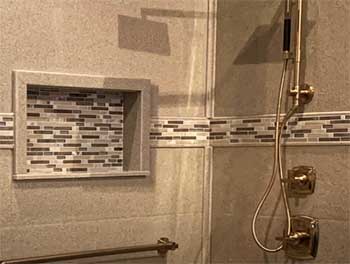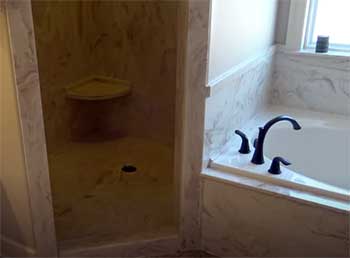When it comes to choosing the right material for your shower, the choice might not be as straightforward as you think.
Today, we’ll dive deep into the realm of Onyx and Cultured Marble showers, their key features, benefits, and drawbacks, so you can make an informed decision that suits your needs, style, and budget.
A Brief Comparison Table
| Aspects | Onyx Showers | Cultured Marble Showers |
| Material Origin | Natural Stone (Agate) | Manufactured Product |
| Aesthetic Appeal | Unique, Natural Patterns | Uniform, Customizable |
| Durability | High, Resistant to Chips | Susceptible to Scratches |
| Maintenance | Easy, Non-porous | Can Yellow Over Time |
| Cost | More Expensive | More Affordable |
| Installation | Requires Professional | DIY or Professional |
Understanding Onyx Showers
Onyx, a semi-precious variety of agate with bands of color, has been used in bath and kitchen projects for years. Its unique swirls and shimmering iridescence give it a captivating visual appeal that’s hard to resist.
But it’s not just about aesthetics; Onyx showers come packed with features that make them worth considering.
Pros of Onyx Showers:

- Visual Appeal: Onyx showers boast unparalleled beauty. They are available in a variety of colors, patterns, and finishes, adding an air of sophistication and luxury to any bathroom.
- Durability: Onyx is incredibly durable and resistant to chips and cracks. This resilience makes Onyx showers a long-lasting choice for any home.
- Easy Maintenance: Onyx is non-porous, which means it doesn’t absorb water or harbor bacteria. It’s easy to clean and doesn’t require the use of harsh chemicals.
Cons of Onyx Showers:
- Pricey: Onyx showers can be quite expensive due to the material’s rarity and the labor-intensive manufacturing process.
- Requires Professional Installation: Installing an Onyx shower isn’t a DIY job. It requires professional installation to ensure a proper fit and finish, adding to the overall cost.
- Color Variations: Although its unique patterns are part of its charm, Onyx can sometimes show color variations, which may not appeal to those desiring uniformity.
Examining Cultured Marble Showers
Cultured Marble, on the other hand, is a manufactured product made from a mixture of polyester resin, limestone dust, fillers, and pigments. It’s cast into molds to create shower panels, sinks, countertops, and other bathroom fixtures.
Pros of Cultured Marble Showers:
- Affordable: Cultured Marble showers are generally more affordable than Onyx, making them an excellent option for budget-conscious homeowners.
- Wide Variety of Styles and Colors: Cultured Marble showers come in a range of styles and colors, offering homeowners the flexibility to match their décor.
- Non-porous and Stain-Resistant: Like Onyx, Cultured Marble is non-porous, making it resistant to stains, mildew, and bacteria.
Cons of Cultured Marble Showers:
Let’s check out some problems with cultured marble bathroom:
- Susceptible to Scratches: Although durable, Cultured Marble is susceptible to scratches and needs to be handled with care.
- Can Yellow Over Time: If not properly maintained, Cultured Marble can yellow over time, diminishing its aesthetic appeal.
- Not as Unique: Since Cultured Marble is a manufactured product, it doesn’t have the same unique, natural beauty that Onyx offers.
Key Differences Between Onyx and Cultured Marble Showers
When comparing Onyx and Cultured Marble showers, it’s crucial to delve into the key differences that set these materials apart. Here’s a breakdown:
- Material Origin

The first key difference lies in the origin of the materials.
Onyx is a semi-precious form of agate, a naturally occurring stone, characterized by parallel bands of chalcedony in alternating colors.
It’s a type of quartz and is mined from the earth.
On the contrary, cultured marble isn’t a natural stone but a manufactured product.
It’s a blend of polyester resin, limestone dust, fillers, and pigments, cast into specific shapes to produce bathroom fixtures, including shower panels.
- Aesthetic Appeal
When it comes to aesthetics, Onyx offers a unique beauty that’s hard to match. The naturally occurring bands create a rich, luxurious, and one-of-a-kind look, ensuring no two Onyx showers are identical.
Cultured Marble showers, although elegant and polished, lack the unique natural patterns found in Onyx. However, they are available in a variety of colors and styles, which can be customized to fit your interior design preferences.
- Durability and Maintenance
Onyx is renowned for its durability. It’s highly resistant to chips and cracks, making it a long-lasting choice. The non-porous nature of Onyx also means it’s easy to clean and doesn’t harbor bacteria.
Cultured Marble, while also durable and non-porous, can be more susceptible to scratches. It also has the potential to yellow over time if not properly maintained.
- Cost and Installation
Generally, Onyx showers are pricier than cultured marble showers. This cost difference is due to Onyx’s rarity and the labor-intensive manufacturing process. In addition, Onyx showers often require professional installation, which adds to the overall cost.
Cultured Marble showers, on the other hand, are more budget-friendly. They offer an excellent balance of cost, durability, and aesthetics, making them a popular choice among homeowners.
Each material has its own set of advantages and potential downsides. Your choice between an Onyx and Cultured Marble shower will depend on your specific requirements, taste, and budget.
Frequently Asked Questions (FAQ)
No, onyx and cultured marble are not the same. Onyx is a natural stone with its unique swirls and patterns, while cultured marble is a man-made product created from a blend of polyester resin and limestone dust.
Whether Onyx is better than marble really depends on individual preferences and needs. Onyx offers unique beauty and durability but comes with a heftier price tag. Cultured marble, on the other hand, is more affordable and offers a wide variety of style options.
Yes, Onyx tends to be more expensive than cultured marble due to its rarity and the labor-intensive process involved in its extraction and manufacturing.
No, the Onyx Collection is not cultured marble. It is a brand that offers bathroom products made from a blend of alumina trihydrate (crushed stone) and a specially formulated resin, providing a similar look to Onyx but with enhanced durability and maintenance benefits.
Wrapping Up
Both Onyx and Cultured Marble showers have their strengths and weaknesses. The choice between the two will depend on your budget, style preference, and maintenance expectations.
By comparing the features, pros, and cons of both materials, you can make an informed decision that best suits your needs and ensures that you enjoy your shower for many years to come.
